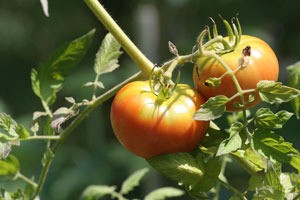
Lycopersicon esculentum
Tomatoes are members of the nightshade family. Originally from South and Central America, today the tomato is grown worldwide for its brightly colored, edible fruits. Red tomatoes contain the pigment lycopene, a well-known antioxidant thought to help prevent some cancers.
Sow seeds outdoors when air and soil temperatures reach 60F. Set transplants out when nighttime temperatures stay above 50F. Sow seeds indoors 6 to 8 weeks before transplanting.
full sun
loose, well-drained, nutrient-rich soil with a pH of 5.5 to 6.8.
Plant seedlings in large holes supplemented with kelp and bone meal to provide plants with the extra potassium and phosphorus they need. Allow at least 2 to 3 feet between staked plants in rows spaced 3 feet apart. Sow seeds directly 1/2 inch deep and 2 inches apart.To plant tomatoes in trenches, strip all but the top sets of leaves from plants and place them on their sides in a 2 to 3 inch trench. Firm the soil around the plants and as they grow, the plants will turn upward while the buried stems produce roots. Use this method if transplants are tall and leggy at planting time.
Tomatoes are also well suited to growing in containers. Look for cultivars that are specifically bred to be 'patio' plants.
Keep soil evenly moist (not wet). Water from the ground and early in the day to help prevent disease. Keep plants watered well during dry periods.
Support plants with stakes or cages if necessary. Snap off any suckers (off-shoots) that appear between the main stem and the stems of the leaves to focus the plant's energy on producing fruit. If your soil is poor in nutrients, feed plants a solution containing fish emulsion once per week until the plants flower. If plants are growing vigorously with dark green leaves, they do not need nitrogen. Too much will increase leaf production and decrease fruit production. On the other hand, yellowing leaves may indicate a need to add nitrogen. Areas with extremely warm summer temperatures may need to protect fruit from sun scald and prevent blossom drop.
Tomatoes are ready to harvest when they have developed their full, mature color. Harvest them ripe or while still slightly green and let them ripen at room temperature out of direct sunlight. Cold causes flavor loss so do not refrigerate them. Harvest all remaining tomatoes before the first hard frost. Freeze extras, or if still green, store them in a box filled with newspaper in a dark room (at 55 to 60F) and they will continue to ripen over several weeks.
Unfortunately, tomatoes are susceptible to damage from a wide variety of insects and diseases. Purchase seeds or plants that are resistant to common tomato diseases and don't plant in areas that have had tomato troubles in the past. Keep soil moisture consistent to help prevent fruit from cracking and water plants early in the day (from the ground) so leaves have time to dry before nightfall. Check for worms and caterpillars that can be picked off by hand and for signs of aphid infestations that can be sprayed off with a hose.
Tomatoes cultivars are either determinate (grow to a specific height, flower and produce in short time) or indeterminate (grow, flower and fruit over a long period of time). Determinant tomatoes are good for large crops used for canning. Indeterminate varieties are best if you want to pick tomatoes to eat fresh.
Many of today's tomatoes are hybrids and won't breed true if seeds are saved and planted the following season. If growing plants with the intention of saving seed, choose heirloom varieties for offspring that reproduce true to their mother plant. Mixing some lime into the soil adds calcium that will help balance soil minerals, helping prevent some types of fruit deformities as well as blossom end rot.

Add your voice! Click below to comment. ThriftyFun is powered by your wisdom!
An interesting fact I discovered about tomatoes is that they are actually a perennial, but we treat them as an annual.
Add your voice! Click below to comment. ThriftyFun is powered by your wisdom!